My grandfather, from my mom’s side, was a high-ranking officer in the Mexican army. He passed away when I was very young, perhaps eight. But I spent much time with my grandmother in their giant house. A house filled with army memorabilia and artifacts — from (non-live, I like to think) ammo, grenades and mortar shells to books, manuals, certificates and, my favorite, toys. The nicer, more valuable ones made out of tin were in a vitrine locked with a key. Seldom could I play with those. There was, however (and no matter how many we invariably lost), no shortage of plastic green army men that my brother and I could play with in the giant backyard that was, in our young minds, landscaped specifically to carry out epic battles of these massive armies of faceless, motionless, plastic toys.
As I grew up, my taste in bellicose toys — which my parents were happy to satisfy without worrying that I would turn into a mass murderer or serial killer, a lack which I eternally thank them for — evolved into the multiple-jointed G.I. Joe action figures during their 80s heyday. With their removable weaponry, backpacks and helmets and an endless array of fighting vehicles, I collected them with reckless abandon and played with with equal chutzpah in my backyard — by myself now or with my neighbor, as my brother was now older and wearing Z-Cavaricci pants. But, with the added realism of G.I. Joe, my battles became prescribed and repetitive, it was always G.I. Joe against Cobra, good versus evil. Their specificity did not allow for much interpretation and limited my imagination. In retrospect — and before I had read ten reasons why plastic army men are better than action figures [pop-up] — the plastic army men forced us to create story lines, we had to divide them in equal quantities and allocate ranks, battalion names and declare what they were fighting for — we were forced to assign meaning to them because, at least to us, they lacked any.
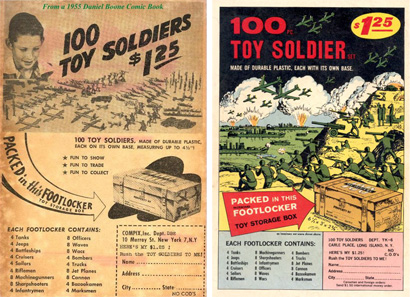
Advertisements in comics from the late 1950s – early 60s.
[Click image for larger view]
These plastic toy soldiers — minimalist replicas of World War II soldiers’ uniforms, weapons and demeanor initially sold in the early 1950s by the bucketload — triggered no direct relationship to war for us, I was young enough to have no clear understanding of the two World Wars and I only learned of the Vietnam war much later when I sat with my brother as he watched Platoon. Still, they posed no threat. In their smallness and lack of detail — not to mention, that soldiers didn’t look like that anymore nor did they use bayonets — they were merely anonymous plastic figures upon which we could project our own adventures and imagination. Interestingly, this innocence and visual accuracy pinned to more than four decades has given the plastic army man an array of personalities: from lukewarm political message, to kid-friendly merchandise, to lowbrow humor.

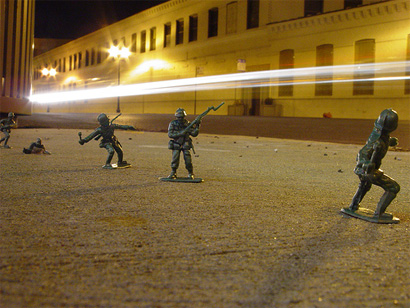
Photo © Fuzzy Gerdes.
In 2005, New York-based activist group, Mouths Wide Open, launched the Army Men Project. A call to bring soldiers back from Iraq. With raging support from people like Sallie Gratch in Evanston [PDF], thousands of green army men have been left throughout the nation, motionless and out of context, urging action.
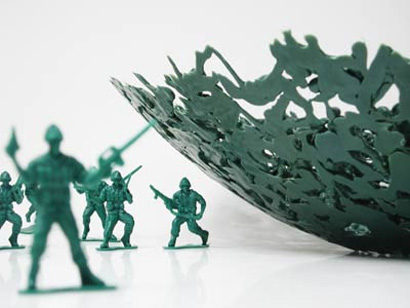
Since 2002, British artist/designer Dominic Wilcox has been producing the War Bowl, a childhood-satisfying project (melting army men is way fun) that blends product design with a soft political message open for interpretation. And making your own is not as easy.
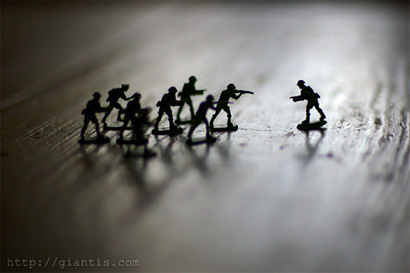
Photo © Zach Hollandsworth.
On Flickr, a group photo pool under the guise of Unseen War, handles images of “the battles that toy Army men fight to keep the rest of the toy box safe.” While lighthearted in its purpose, some of the images in that pool are quite provocative of more serious consideration.

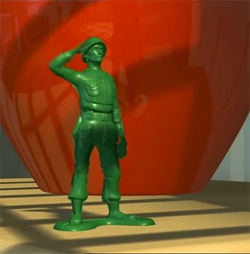
If one were to try to pinpoint the moment where army men became popular in the mainstream again, it would likely be the hugely successful 1995 Pixar movie, Toy Story and its 1999 sequel where they play tertiary roles at best, but to quite the popular acclaim. Disney followed Toy Story 2 with a spin-off children’s book, Disney’s Little Green Army Men.

Circa 1998, the Army Men series of video games was released. First on PC, later on all the major consoles. With more than a dozen variations on the theme, new titles are being released with fervor.
[Click image for larger view]

Saving Private Ryan meets frat boy humor. Blowing up army men with firecrackers is one of teenagers’ favorite pastimes, one that with YouTube has risen to an art form. More serious filmmakers also have their place in a kick-to-the-groin-fun world.

It takes a certain kind of man-child to dress and be painted as an army man, luckily there are quite a few.[Click image for larger view]

Plastic army men are a rare breed of visual icon — almost like our good friend, the blackletter — that can ambiguously straddle between moods and motives without one extreme (cute Disney characters) negating the other (eerie protest figures). And in the hands of a graphic designer, a few of these extremes could be, literally and metaphorically, exploited: Oliver Munday, an upcoming graduate of Maryland Institute College of Art (MICA) designed a typeface constructed from exploded and burned army men as a class project — one of only nine student winners in the 2007 STEP 100 annual. Following is our conversation about his project.
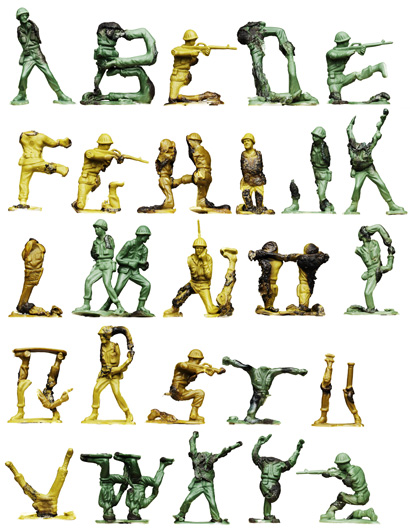
Fire in the Hole by Oliver Munday.
AV: Can you explain your project, in a general sense?
OM: The class was “Experimental Type” taught by Bruce Willen and Nolen Strals of Post Typography, Baltimore. The assignment was to create a 3-Dimensional alphabet out of anything that we wanted. In the beginning I had absolutely no idea what to do, but I was leaning towards doing something with the human body/form, but it had been done quite a bit, and I was trying to think of an alphabet that no one had ever seen. Thinking about the human form led me to think about toys which led me to the army men. They were perfect for me because they are such a classic toy that many generations could relate and respond to them — I don’t think I was the only one who burned them when I was a kid, I was a bit of a pyro when I was a child, and I can remember burning them along with lots of other toys. I also liked the fact that through the humor of the alphabet that there is a serious/emotional side to the alphabet that a few would respond to, regarding the current state of the World. I was a little nervous that someone would take it personal or be offended by it, but everyone seemed to enjoy it. The main thing that I wanted was people to react to it, whether it was a laugh or a cry. It’s always nice when you see design affect someone on an emotional level.
AV: So you were not looking to make some sort of political statement from the start? You arrived to it through a design process. What were some of the other things you considered?
OM: For certain projects I like to make some sort of comment or statement, whether it’s political, social, etc… but with this project it was not like that from the get go. After thinking about the army men, the fact that there was a political message that could be communicated excited me, and I was curious to see what people’s reactions would be. I didn’t really consider much, I came to the idea of army men rather quickly. In some ways it probably was the state of war that the U.S. and the world was in that helped me arrive at the idea so quickly.
AV: How did you actually go about doing the full alphabet? Did you sketch it out first? Or did you just play with the army men and burn some limbs off?
OM: I didn’t do any sketching for this piece, I went straight into it, probably because the process of making it was so intriguing, plus it was a legitimate excuse to play with fire.
AV: There is something very powerful and primal in the actual, physical effect of a burned plastic army man. At some point did you think that this might just be too “graphic”?
OM: There is something very powerful about the figures themselves, the act of creating them was very primal. You can see the effects of the burning. You can really see the scorched edges, and the gradient of browns and greens from the flame, the details of burned plastic are pretty amazing.
After they were done and I looked at the lot of them, I was a little worried that they might be too graphic, I thought there might be some who were offended by it, but most of the time that’s the risk of pieces that make some sort of comment on politics, race, and other social issues. In the end no one spoke out about being offended, the feedback was pretty much all positive.
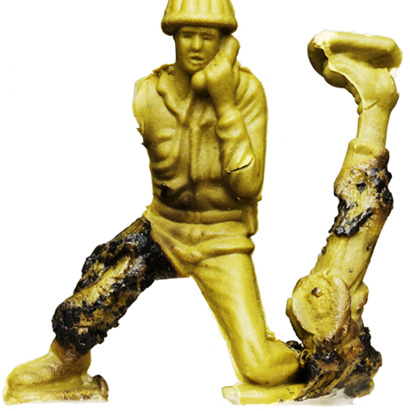
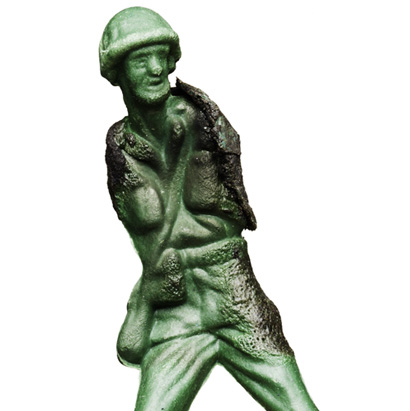
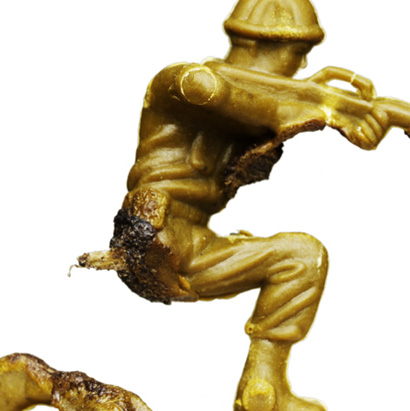
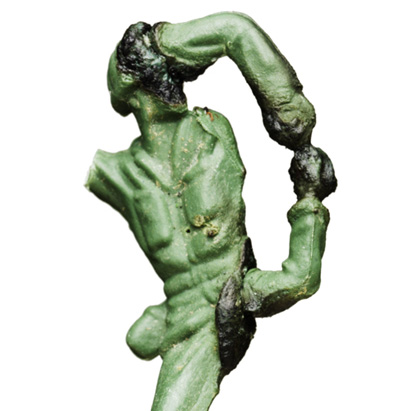

It has been more than two decades since I played with plastic army men, pitting a swarm of them against another. It is encouraging to know that they still have many, giant battles with a myriad of imagined and unimagined enemies… Lucky for them, there is strength in numbers.










another silly article, armin.
On Mar.20.2007 at 09:40 AM